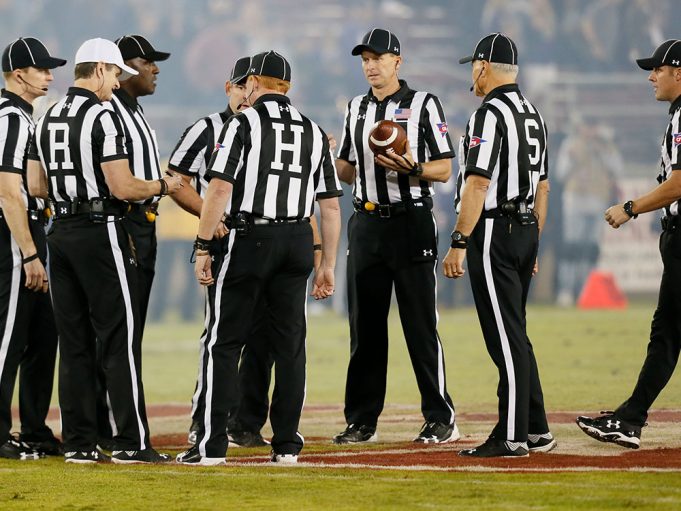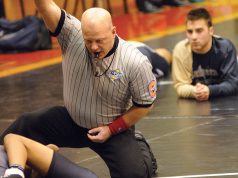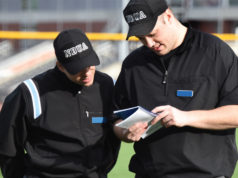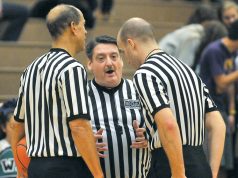A college football game encompasses 60 minutes of playing time divided into four 15-minute quarters. But those 60 minutes typically require something approaching three hours to complete, and games at the NCAA FBS level typically last longer than that.
There’s a lot of down time in a college football game, particularly at the sport’s highest levels. How should officials utilize that time to maximum advantage?
Retired college football referee Mike Defee was considered one of the premier officials in the sport. He worked in the Big 12 Conference beginning in 2006, first as a back judge and then in 2010, as a referee. His résumé includes an assortment of major bowl games and the 2017 national championship game between Alabama and Clemson.
There is an abundance of down time in games he and his crew work each week, in part because of the demands of television.
Four media timeouts each quarter, lasting approximately three minutes each, plus additional breaks after the first and third quarters (three-and-a-half minutes each), add up to nearly an hour of real time. And that’s not including the 20-minute break at halftime. All of which explains why high-profile FBS games can last close to four hours from opening kickoff to final whistle.
But Defee took pride in staying focused during stoppages. “That’s something I feel really, really strongly about,” he says. “I believe in that old saying that ‘Idle time is the devil’s workshop,’ and so during media timeouts, I always wanted to stay in the moment.”
Stay busy during a timeout
It should be noted that the crew stays busy during a timeout.
While Defee remained at his post behind the offense, there was communication going on between crew members.
“My umpire or I, one of us, would initiate it,” Defee says. “We’d point at the sideline just as a reminder of how many timeouts each team had (remaining).”
Defee notes that his wing officials — the head line judge, the line judge, the field judge and side judge — would station themselves near the team huddles during timeouts to handle any issues that arose. With 30 seconds left until play resumed, the back judge, who was with the timeout coordinator (red hat) on the field for media timeout stoppages, would return to his position. Fifteen seconds later, the wing officials instructed the teams to return to the center of the field so Defee could make the ball ready for play the moment the timeout ended.
“It’s all about trying to be as efficient as we can,” Defee says.
The crew may also utilize a media timeout to consult with each other about what’s happening in the game and what they’re seeing.
“It may take a media timeout before I have an opportunity to talk to my umpire and tell him, ‘I really didn’t get a good look at (a previous play),’” Defee says. “I’ll say, ‘That sweep play six or seven plays ago. Did you get a good look at number 59? The guy went to the ground and I didn’t see how he went to the ground.’
“Those types of things you communicate during timeouts. Otherwise, it’s just simply staying in the moment. I feel like I can concentrate for the better part of two hours until I get to halftime.
“At halftime, I get a little bit of a mini-break there, and then we’re re-engaged for an hour and 45 minutes roughly, whatever the second half runs. I’m a big proponent of staying in the moment during those timeouts.”
Addressing Your Crew
The last game of Gene Steratore’s 15-year NFL career (eight of them as a referee) was Super Bowl LII between the Eagles and Patriots following the 2017 season. Steratore would often utilize media timeouts to address his crew.
“Not always, but a majority of the time, I would hit my blue button (on his crew communication device) and give a brief little pep talk,” he says. “Something motivationally about where we were in the game, how well the flow was going, or just a general overview, for maybe 20 or 30 seconds.”
Steratore, who also worked NCAA men’s Division I basketball before retiring at the end of the 2018 season, would also utilize breaks in the game to talk to coaches if it was necessary. He stresses the importance of keeping the lines of communication open.
“Before the game, part of my conversation with the coaches was, ‘I want you to know that we can communicate this entire day,’” Steratore says. “‘I may not be able to get to you immediately (based on the game situation) but I will get to you as quickly as I can.’ That was my way of letting them know if there was a play in a series (that the coach had a question about) and then a punt occurred, that I would immediately go there.
“That might pop up, not even once a game. Every other game, you might have that talk.”
College basketball timeout protocols vary according to the level of play and the agreement between a media partner and the conference involved.
For D-I men’s games, the most common scenario calls for media timeouts on the first dead ball following the 16-, 12-, eight- and four-minute marks of each half, which generally last either 60 or 75 seconds, depending on the host institution/conference involved or the electronic media agreement. In addition, each team receives one 60-second timeout and three 30-second timeouts per game; only two of the latter carry over to the second half.
J.D. Collins, the NCAA’s national coordinator for D-I men’s basketball officiating, says the protocol for officials during a 30-second timeout is straightforward.
“They go to their spots,” he says. “They should mentally rest just for a few seconds and then begin to roll into the next series of plays.”
A full timeout is almost always a media timeout at the D-I level. Those stoppages can be prolonged, particularly during the NCAA tournament, and sometimes redundant; if there is a lengthy period without a whistle, consecutive media timeouts can occur with only a few seconds of elapsed game time in between.
Whatever the situation or scenario, Collins says officials should remain mentally engaged.
“Meaning, reviewing plays in the last four-minute segment in their brain,” he says. “‘I want to look at the play at 12:52’ and register that play and then reset, and begin to think about, ‘What’s all going on in the game right now?’ Doing a quick mental assessment; ‘Are we too physical? Are we calling it too tight?’ All those kinds of things.”
Timeouts also offer an opportunity for members of the crew to communicate with each other, if necessary. Collins says such conversations can be useful early in a game; the crew might be concerned it’s calling the game too closely or too loosely, and that the game is developing a good flow.
“Whatever the discussion needs to be, sometimes it’s necessary,” he says. “Sometimes in the middle of the game it’s not necessary, (the officials) have a good flow going to the game.”
Collins says crew conferences are particularly useful toward the end of a game. “Most of the time at the end of a game they need to get together to discuss all of the possible scenarios,” he says.
“What are the possibilities? ‘(Is the offensive team) going to drive the ball inside? Are they going to shoot a three? Do we need to look at the feet? Who’s got the shot?’
“Go through the possible scenarios that could exist and make reminders to one another so that it puts the thought in (the crew’s) heads, ‘We have to be prepared for X.’”
“We may go to the monitor to see if a shot was a two or a three-pointer,” says Infini Robinson, who works an assortment of D-I women’s basketball games on the West Coast. She points out there are often administrative issues to be dealt with during extended timeouts.
“We handle any administrative issues at the table, involving the scorer or the table crew.”
Robinson also makes sure she’s available to coaches who may have a question or concern. “They may have a question about where the ball will be inbounded,” she says, “or plays. Or questions about a specific rule.
Huddle as necessary
“As a crew we’ll also huddle to make sure we’re adhering to the points of emphasis. We also talk about our consistency as a crew and mental preparation or real-time game situations. ”Robinson notes that officials do all this in order to enhance their level of concentration, individually, over the course of a 40-minute game.
Dr. Margaret “Maggie” Tieman, a sports psychologist, officiates D-I women’s basketball games in various conferences in the Northeast, including the Atlantic 10, and has coached field hockey, basketball and softball at the high school level.
She stresses the importance of maintaining a consistent routine during media stoppages.
“Just like we have a preshot routine in golf or any pregame routine in any kind of sport that we do, I have a routine that I do during media timeouts,” she says, “knowing that they’re going to be anywhere from two to three minutes long.
“The first piece is purely mechanics and positioning. The next course of action is ball position and clock. Making sure that you know where the ball is going to be put in play whether it was an AP (alternating possession) throw-in or just a regular out-of-bounds play and then memorizing the clock (the last two digits on the game clock and shot clock). So, if something happens to the clock, we can put the correct time back up without having to go to a monitor. It’s always quite embarrassing when the kids come out of a timeout and they ask whose ball it is and we don’t know whose ball it is.
“The second item I think about is crew communication because sometimes we meet together as a crew, sometimes you just go to your spot, whether it’s a 30-second or 60-second timeout.
“You say the same things to yourself regardless of whether it’s together in a crew huddle or I’m standing on a block. The items I go through are the same, no matter what.”
What's Your Call? Leave a Comment:
Note: This article is archival in nature. Rules, interpretations, mechanics, philosophies and other information may or may not be correct for the current year.
This article is the copyright of ©Referee Enterprises, Inc., and may not be republished in whole or in part online, in print or in any capacity without expressed written permission from Referee. The article is made available for educational use by individuals.



















